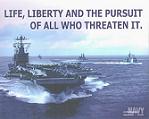http://news.yahoo.com/s/ap/20100805/...carrier_killer
Bring the battleships back!
The most important thing I got out of the article was not the point that the Chinese might be able to sink our carriers from 900 miles away, but the missile is cheap and evens the playing field.












 ) is to focus on what primary geopolitical focus the US will have in the upcoming decades.
) is to focus on what primary geopolitical focus the US will have in the upcoming decades. 



Bookmarks